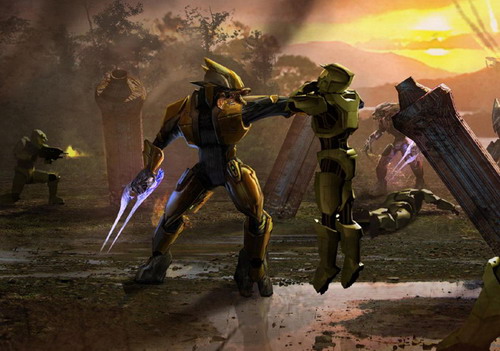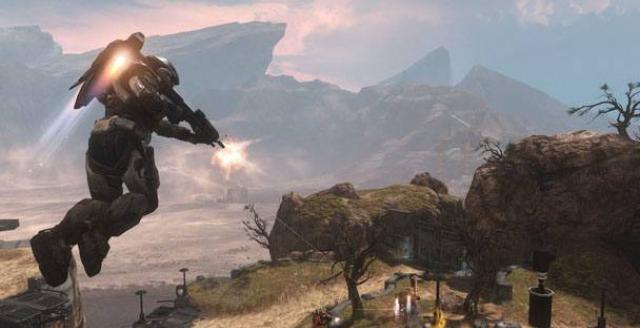In what sub-genre does Halo belong? Arcade shooter, arena shooter, story-driven shooter, vehicle-based shooter? It’s all of these and none of them simultaneously, which confounds any effort to define the "Halo Factor" into any reasonable set of details. And with the evolution of the series, attempts to pin down Bungie’s "gift to the gaming world" only become more confused or inexact. That’s why most reviews for Halo: Reach are content to make the statement, "If you love Halo, then you’ll die for Reach." And while it’s true, what does that mean for those who felt luke-warm about the Halo franchise to this point? Will the naysayers be silenced when the gaming earth opens up and swallows them whole for even doubting the success of Reach, whether fundamentally or generally?
An observation made by Adam Sessler of G4TV seems telling in this instance. He noted that nowhere in the actual game did he see the word "Halo" (save perhaps the credits), which makes sense given the timeline that Reach falls under as a prequel to Halo 1 through 3. But more importantly, it signals that Reach is a game that has tried to remove itself from the confines of the series that gave it form, but to only mild success. That’s not to say that the game in itself is unsuccessful, but simply that in trying to recreate the Halo experience (everything was redesigned from the ground up — character models, vehicles, gameplay mechanics, etc.) to tell a new story and to reinvent multiplayer, Bungie only half-distanced themselves from tradition. So to say that fans of the Halo series will absolutely love Reach is really to assert that the half that feels familiar and the half that’s brand new both achieve their maximum potential or close to it. I would argue otherwise.
Reach plays into the hands of its fans very well, allowing for some of the deepest customization yet, a unilateral points system — credits — for tracking accomplishments on- and offline, and a single-player experience that takes the original Halo ideas and builds on them. The story of Reach is a tragedy, beginning at the end of an era for humans on the titular planet at the hands of the alien horde, the Covenant. You won’t see any Flood this time around, so the enemy remains consistent throughout, but there are enough minor plot twists, atmospheric details, and convincing characters to keep attentive players engaged. But like other Halo titles, players not paying close attention to radio comms in the middle of a huge firefight or some side comment made during a period of transition will be completely disconnected from their objective, simply following an arrow from A to B and slaying all manner of Covenant in the way. That’s not to say that the campaign without any informed perspective on the story is in any way boring; far from it. The game just asks a lot of the player, which many will likely not respond to positively.

Gameplay variety easily reaches its peak this time around the galaxy, jumping from vehicle combat to standard FPS to space battles to aerial wars. I think that sort of variety is something Halo fans have always loved, so mixing it up with some traditional and brand new elements hits the nail on the head. This does come with a caveat, however, in that if you are looking for a straight FPS title, vehicle shooter title, or anything else, you won’t find it. Reach is an amalgam of gameplay types in a way most other shooters cannot rival, frenetically so at times. Personally, I love the options available when approaching a battle, so it’s a plus in my book. But this could turn off gamers looking for a purer experience.
The ending of the campaign blows the grunt out of any other Halo ending with originality, creativity, and the way it beautifully ties into the themes not only of the Reach campaign but the multiplayer as well. Believe me, this does not in any way spoil it for you — it’s rather unexpected. But while the ending thrives, and most missions have enough character and variety to pull the player along quickly, there’s just a bit too much defending. That is, there are an inordinate number of objectives throughout the campaign that require the player to stake out a position, person, or object and defend it against waves of enemies until they can proceed. Isn’t that why there’s Firefight Mode?
The Reach campaign, although polished and peppered with excitement, is only half the battle, if not less. Like any Halo title, so much depends upon the multiplayer, which is where Reach does its best. It sticks to its guns by not entirely going the way of Call of Duty games with customizable perks, loadouts, or killstreaks. But in a lot of ways, Reach adapts those ideas to fit into the Halo formula. It begins with the credits system, which awards players with credits based on performance that can then be used to customize appearance and sound, and nothing else. And loadouts make an appearance in Reach, but all are predetermined sets of weapons and abilities to choose from, and the available loadouts are mandated by map, game type, and only sometimes performance. The whole system feels very appropriate; unlikely to stir up too much dissent among Halo purists, but fresh and varied enough to provide a new experience for those who want one.
Multiplayer is ultimately about maps and modes, and Reach nails both in quality and quantity. All of the old stand-bys make a triumphant return (i.e. Slayer, Infection, CTF, BR, Rockets, KoH, Juggernaut, Oddball, Territories, etc.). Most of these remain true to traditional Halo multiplayer standards, playing out over 13 brand new map variants and one fairly faithful recreation of Blood Gulch from Halo. Where the multiplayer gets really fun is with the new game modes, Invasion and Headhunter. Standard Invasion pits the player as a Spartan and then an Elite (or vice versa) in a battle to capture territories and objectives across the bigger maps, unlocking new items, vehicles, and abilities along the way. A variation on Invasion is Invasion Slayer, which plays like a regular Slayer match but with periodic upgrades based on the ability of teams to secure certain areas. Headhunter is more frantic and less strategic, involving a mad combination of offensive and survival skills in order to kill enemies, collect the skulls they drop (think Sonic’s rings), and then keep from dying when you’ve got graveyard full of ’em. It’s fast, it’s intense, but mostly it’s just a lot of fun.

As for the basic multiplayer mechanics, a few minor details have been tweaked that change the experience in big ways. First of all, the weapons (also applicable to campaign mode). The battle rifle has been usurped by the DMR, a semi-automatic single-shot rifle with a real punch. The Covenant equivalent is a Needle Rifle, also single-shot but with a faster rate of fire and an explosive final round. Other big additions include the Plasma Launcher, Grenade Launcher, Focus Rifle, and Concussion Rifle, but the big game-changers are the mid-to-long-range single-shot rifles. They aren’t completely evenly balanced, with the edge towards the DMR, but the Elites also start out with plasma grenades which makes a big difference. One major change regarding existing weapons is the dramatically decreased rate of fire on the shotgun, which makes each shot count that much more. Everything else plays about like it used to, with a slight increase in bullet damage returning to the fabled Magnum.
The biggest change in terms of gameplay (also applicable to the campaign) is the armor abilities: Sprint (Spartan only), Dodge (Elite only), Armor Lock, Hologram, Jetpack, and Drop Shield. Each of these is extremely situation dependent, so careful decisions can go a long way on the right map. The surprising aspect, I found, is how well the abilities balance in combat. Maybe it’s just because players haven’t figured out how to manipulate one power or map to their distinct, over-the-top advantage just yet, but it feels like the armor abilities mostly serve to augment the play style of any combatant. This in itself achieves something few other modern shooters have been able to accomplish and deserves applause. Dropping in on enemies with the jetpack is a blast, escaping from a sticky situation with a roll or sprint is incredibly useful, and the other abilities work surprisingly well to turn the tide of specific situations. For the armor abilities I say kudos to Bungie.
The thing to remember with Halo: Reach is that despite the variants of the armor abilities and the gameplay types in the campaign (I still think there should be some multiplayer space combat), it still narrowly appeals to Halo fans. Bungie succeeds by giving their fans the farewell letter they always wanted, but doesn’t go so far as to break the mold of the series. If you are going to love Reach, it’s because you knew you’d love it before even playing it. I’m conflicted, because they pull off one hell of a Halo game in Reach, but fail to expand beyond the confines of what the franchise has always been about. It’s the arcade/arena/vehicle/sci-fi shooter of this generation, no doubt. Any Halo fan without Reach misses out on what’s sure to be a great addition to their library. A game changer, however, it is not.


















